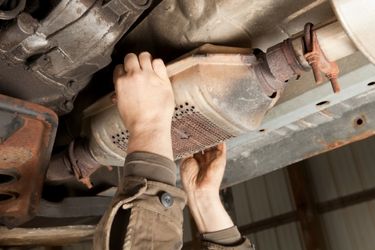
Written by Kayla Jane Barrie Updated on Mar 04, 2025 5 mins read

Canadians have been on alert over the last year due to the increase in catalytic converter theft. Thieves have discovered that this auto part has highly valuable metal inside.
Although this theft has always been an issue, it’s been on the rise nationally. According to CBC Calgary, police said converter thefts rose from 300 reported incidents in 2020 to 1,014 in just the first eight months of 2021. In Edmonton, there were 2,484 reported thefts between November 2020 and October 2021 — an increase from 1,697 over the same period the previous year.
What can we do to prevent these thefts? Will repair and replacement be covered by car insurance? Find out in this blog post what provinces are doing to protect drivers and the impact catalytic converter theft is having on Canadians and insurers.
Catalytic converters are part of your vehicle's exhaust system. It recombines gasses to reduce harmful emissions, such as mixing carbon monoxide with oxygen so it becomes carbon dioxide before being expelled. They can reduce around 90% of harmful toxins in the air.
It was first invented in 1950 by French mechanical engineer Eugène Houdry. As scientists were beginning to learn about air pollution caused by vehicles, he created it to clean exhaust.
Catalytic converters are attached to the exhaust pipe underneath a vehicle. It’s a metal box with a ceramic honeycomb inside. The honeycomb is coated with platinum (Pt), palladium (Pd) and rhodium (Rh). These metals resist oxidation, acid, and corrosion, which means they can stand up to chemicals released in a car engine.
People steal catalytic converters because they are easy to remove from vehicles and the precious metals inside. With minimal skills and tools, thieves can remove the converter quite quickly and be on their way to selling to a junkyard or the black market.
Catalytic converters have platinum, palladium and rhodium, which can all be sold to precious metal dealers for between a few hundred to thousands of dollars per ounce. Advanced models of converters can include even more of these metals compared to older models. The metals are worth even more than gold in some markets.
Catalytic converters are worth between $150 and $2,000, but some can be more valuable than others. In 2021, the Insurance Institute for Highway Safety reported the most valuable converters were selling for more than $1,000; these came from second-generation 2004-2009 Toyota Prius.
Cars with high clearance and hybrid vehicles are at the most risk for catalytic converter theft. In 2022, Aviva Canada has seen several Hyundai Tucsons, Mitsubishi RVRs, Honda CR-Vs, Hyundai Santa Fes, and Ford F150s targeted. Those living in the GTA, Ottawa, Montreal, Calgary, and Edmonton areas are the most common for catalytic converter theft.
Below is a list of the top 10 vehicles for stolen catalytic converters, provided by Manitoba Public Insurance.
| Model | Catalytic Converters Sum |
|---|---|
| Honda CR-V | 201 |
| Hyundai Tucson | 198 |
| Hyundai Santa Fe | 129 |
| KIA Sportage | 94 |
| Honda Element | 54 |
| Ford E450 | 52 |
| Ford F150 | 45 |
| Toyota Prius | 40 |
| Ford E350 Van | 33 |
| Honda Pilot | 32 |
It is not recommended to keep driving your vehicle if the catalytic converter is missing. Your vehicle will emit more toxic fumes. If you live somewhere that requires emissions tests, they will fail without a converter.

By simply looking at your car, you may not be able to tell if your catalytic converter was stolen, but you’ll know when you start the engine. You’ll notice a loud roaring noise that will get louder as you push the gas pedal.
Other signs that your catalytic converter was stolen include :
In 2021, Manitoba introduced the Scrap Metal Act (Bill 9) to combat the theft of metals. New Brunswick is also working on a solution, according to CBC. Until more provinces announce law enforcement to deter thieves, the best thing drivers can do is take preventive measures.
Here are four tips to help prevent catalytic converter theft.
Catalytic converter theft is a growing problem for auto insurers across the country. In April 2022, there were over 300 reported catalytic converter theft claims in Manitoba. Winnipeg police data suggests catalytic converter thefts are up 415% over last year. With this theft on the rise, can Canadians seek support from their insurer?
If you have comprehensive coverage, catalytic converter theft should be covered. Always check your policy documents to confirm what is included. If you don’t have any comprehensive protection, you will likely not be covered for any car theft and will need to pay out of pocket for replacement and repairs.
If you own an electric vehicle in Canada, you are protected from thieves because EVs do not have a catalytic converter. Since EVs do not emit any exhaust, the converter is an unnecessary piece of equipment for electric trucks and cars. If you have a hybrid car, keep in mind it will have a catalytic converter since there are still fuel components in the vehicle.
If you are submitting a claim for a catalytic converter, you should take photos, file a report with your local police, and contact your insurer.
If you’re looking for a vehicle less likely to have its catalytic converter stolen, you can try a Mini Cooper, Mazda RX7, Audi and BMWs such as the E46 323i, 325i, or 328i. These cars have the converter placed in different spots, such as under the hood or having a rotary engine.
Diesel vehicles have a catalytic converter under the truck, on the exhaust, between the muffler or on the engine.
Replacing a catalytic converter can cost between $500 and $3,000, depending on your vehicle type.
Yes, after 1975, manufacturers were required to have a catalytic converter included on fuel and hybrid vehicles. Vehicles before then won’t have one installed.
To make sure you are properly covered if your catalytic converter is stolen, take a moment to speak with our team to update your Ontario car insurance. Take the possible precautions to ensure your vehicle is protected from thieves when you park your car.
| Categories | Auto |
|---|---|
| Tags | Auto CoverageAuto Theft and Security |
Read our insurance blog to get helpful tips, information and news.
Has your car been totalled in an accident? Is your car a write off? Learn about vehicle write offs for a total loss insurance claim.
Get the facts on Toronto's auto theft problem. We break down the data, reveal the most-stolen vehicles (including the Honda CR-V and Lexus RX 350), and show which neighbourhoods are most affected.
Dive into the world of auto theft with our blog on the most stolen cars in Canada. See the most stolen cars across Canada, including provincial lists for Ontario and Quebec, and learn how high-risk models can affect your car insurance premiums.
Drive safe this winter! Check out these tips for driving in snowy and icy conditions in Ontario. Get other helpful info and FAQs on winter driving.